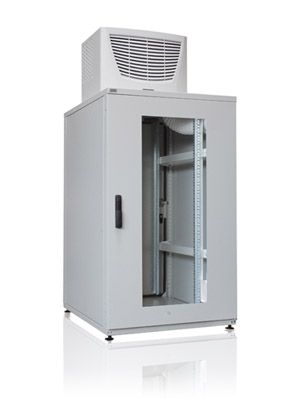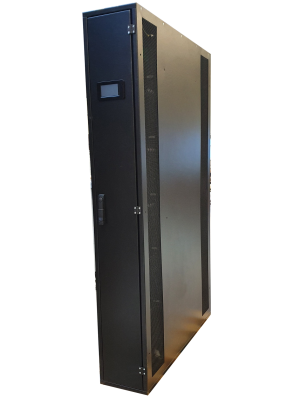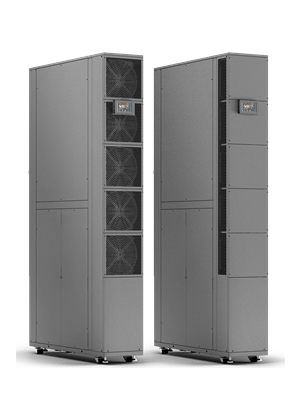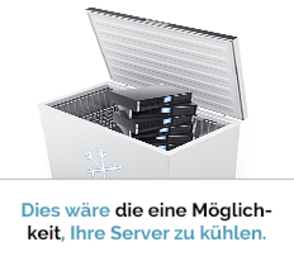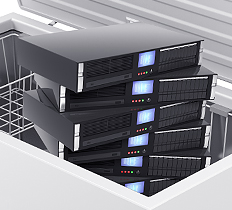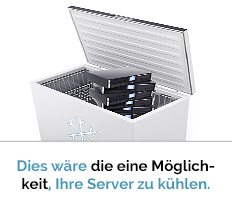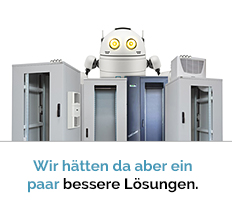19-inch server cabinets with built-in cooling
Server cabinets with built-in cooling are extremely important in times of digitalization, Industry 4.0, and the permanent processing of huge amounts of data to protect IT equipment from possible damage due to high temperatures. At Lehmann-IT you will find a large selection of air-conditioned servers and network cabinets.
Why should IT equipment be cooled?
Electricity flows through electronic IT equipment, which causes heat to be generated and radiated at the same time. In a server cabinet, there are usually several IT devices in a smaller space, which is why the heat from the servers, routers, and switches accumulates and can lead to a temperature that is too high for the equipment. If this temperature is not regulated by cooling, this can have considerable consequences for the devices and components. In addition to reduced performance, damage to the electronics or total failure can be consequences of permanently increased temperature influence. The purchase of a server cabinet with integrated air conditioning can therefore make perfect sense and even save costs in the medium to long term. IT equipment itself is already very expensive, which means that the replacement of the individual devices alone already incurs considerable expenses. Additional costs arise as a result of downtimes and possible data loss, which can exceed the acquisition costs even further. Air-conditioned server cabinets are therefore a sensible investment, especially for companies with large IT systems.
The different cooling systems
Integrated cooling systems have the task of precisely and reliably cooling the contents of a server cabinet. Inside the closed cabinets, the cooling system ensures that the cold and hot air is separated. Precisely these overheated spots, which can occur when the entire room is air-conditioned, are thus effectively eliminated. Especially in server cabinets where IT equipment is very close together, such as those found in large data centers, we recommend using an air-conditioned server cabinet, as heat can accumulate in these. There are various ways to cool server cabinets. Which integrated cooling system is right for you depends, of course, entirely on your requirements and the number of IT devices to be stored in the cabinet. If you need assistance in selecting the cabinet, we will, of course, be happy to help you. Basically, however, a distinction is made between active and passive cooling in 19-inch server enclosures.
Server cabinets with passive cooling
Passively cooled server cabinets use uncooled air that is fed into the cabinet through openings such as vents or perforated doors, creating a natural airflow that keeps the servers, routers, and switches cool. The cooling capacity of passive systems is accordingly very limited. These server cabinets only have a comparatively low degree of protection of IP20 or IP30. Furthermore, server cabinets with passive cooling should only be used in a clean environment, as a high level of dust and dirt transports more particles into the cabinet via the airflow and clogs possible openings there. This would interrupt the airflow and ensure that the warm air can no longer be conducted out of the cabinet. Of course, server cabinets with passive ventilation can be used with low heat loads. However, we recommend always using actively cooled systems. Especially with total power loads of more than 1000 watts inside the cabinet, we advise choosing air-conditioned server cabinets.
Server cabinets with active cooling
In server cabinets with active cooling, a specially installed device is used to supply the inside of the cabinet with cold air. This can be done via a fan or an air-conditioning unit, which is placed on the roof of the cabinet, for example. Alternatively, we also have cabinets on offer that have built-in water cooling in the rear door. In contrast to passive cooling, the cooling capacity of active systems is significantly higher, even in a small space. Since active cooling systems are not dependent on external air circulation, the location of the server cabinet can be chosen much more freely than with models with passive cooling systems. What must be taken into account, however, is the air circulation in the cabinet. Here it is important that the incoming cold air can reach all the equipment in the cabinet. If this is not the case, overheating can quickly occur at these corresponding points, which in turn can lead to equipment failure or breakdown. In our online shop, you will find server enclosure models with active cooling in a wide performance range from 1 kW up to cooling capacities of 35 kW. The cooling capacity you need depends on the heat load of your server enclosure. However, we always recommend choosing a higher cooling capacity to have room for more servers or routers. This way you are also well prepared for possible heatwaves in summer.
Further measures for temperature regulation
Purchasing a server cabinet with integrated climate control usually keeps your IT equipment cool very well, but beyond that, there are other aspects that can be considered to protect the equipment from temperature influences. If you have decided against an air-conditioned cabinet and are in favor of a conventional model, we also recommend that you consider the following measures.
Choosing a suitable place
In principle, good air circulation is important for any cabinet, as this prevents heat from accumulating inside. To ensure that this air circulation is always guaranteed, the choice of a suitable location is also crucial. First of all, you should make sure that there is nothing in the way that can block or otherwise negatively influence air circulation. Possible blocking elements are partitions, shelves, or cabinets. In general, placement in niches should be avoided. Furthermore, depending on the space, other influences can have an impact on the temperature inside the cabinet. For example, if you place the cabinet next to a window through which the sun's rays shine directly on the server cabinet in summer or in direct proximity to the heating system, which radiates considerable heat in the winter months, this also has a direct influence on the temperature in the rack. Furthermore, additional aspects should be considered when choosing a location, but these have no direct influence on the temperature. Ideally, server racks should not be placed in the immediate vicinity of workplaces or places with customer traffic, as they can sometimes emit noise that can disturb your employees and customers. It is also advisable to choose a room where there is not a lot of traffic. Ideally, the room should also be lockable, as this provides additional protection against theft. IT equipment is extremely expensive and should be protected as much as possible.
Regular cleaning measures
Another measure to protect your server cabinet from high temperatures is to carry out regular cleaning. Over time, both dust and dirt can accumulate inside the cabinet and block openings that are relevant for cooling, for example, and disrupt the air supply. But it is not only in the cabinet that dust can collect in the ventilation system; dust deposits inside the IT equipment also lead to increased temperature and consequently to a shortened service life or even component failure. For cleaning a server enclosure, we recommend the use of compressed air. With this, deposits can be easily removed even from the smallest openings. If you do not have the capacity to clean the cabinet regularly, a brief check should be carried out at least every six months to check the actual condition.
Customer service at Lehmann IT
If you have any questions about our server and network cabinets or need assistance in choosing a model, you can of course contact us by phone, e-mail, or our contact form. We will be happy to help you.
Warum sollten IT-Geräte gekühlt werden?
Durch elektronisches IT-Equipment fließt Strom, was gleichzeitig dazu führt, dass Wärme erzeugt und ausgestrahlt wird. In einem Serverschrank befinden sich in der Regel mehrere IT-Geräte auf einem kleineren Raum, weswegen sich die Wärme der Server, Router und Switches staut und zu einer zu hohen Temperatur für die Gerätschaften führen kann. Wird diese Temperatur nicht durch eine Kühlung reguliert, kann dies erhebliche Folgen für die Geräte und Komponenten haben. Neben einer reduzierten Leistungsfähigkeit können Beschädigungen an der Elektronik oder Totalausfälle Konsequenzen von dauerhaft erhöhtem Temperatureinfluss sein. Die Anschaffung eines Serverschranks mit integrierter Klimatisierung kann also durchaus sinnvoll sein und auf mittel- bis langfristige Sicht sogar Kosten einsparen. IT-Equipment selbst ist bereits sehr teuer, wodurch allein durch den Austausch der einzelnen Geräte bereits erhebliche Aufwendungen entstehen. Zusätzliche Kosten entstehen infolge von Ausfallzeiten und möglichen Datenverlusten, welche die Anschaffungskosten nochmals übersteigen können. Klimatisierte Serverschränke stellen also speziell für Unternehmen mit großen IT-Systemen eine sinnvolle Investition dar.
Die verschiedenen Kühlsysteme
Integrierte Kühlsysteme haben die Aufgabe, den Inhalt eines Serverschranks präzise und zuverlässig zu kühlen. Innerhalb der geschlossenen Schränke sorgt die Kühlung dafür, dass die kalte und heiße Luft getrennt wird. Eben diese überhitzten Stellen, die bei einer Klimatisierung des gesamten Raumes auftreten können, werden so wirksam beseitigt. Speziell bei Serverschränken, in denen IT-Geräte sehr dicht beieinander liegen, wie sie beispielsweise in großen Rechenzentren zu finden sind, empfehlen wir auf einen klimatisierte Serverschränke zu setzen, da sich in diesen die Wärme stauen kann. Um Serverschränke zu kühlen, gibt es verschiedene Möglichkeiten. Welches integrierte Kühlsystem das richtige für Sie ist, hängt natürlich ganz von Ihren Anforderungen und der Anzahl, der im Schrank zu verstauenden IT-Geräte ab. Falls Sie Unterstützung bei der Auswahl des Schranks benötigen, stehen wir Ihnen selbstverständlich gerne zur Verfügung. Grundsätzlich wird bei 19 Zoll Serverschränken jedoch zwischen aktiver und passiver Kühlung unterschieden.
Serverschränke mit passiver Kühlung
Bei passiv gekühlten Serverschränken wird ungekühlte Luft verwendet, welche durch Öffnungen wie Lüftungsschlitzen oder perforierte Türen in den Schrank geleitet wird, sodass ein natürlicher Luftstrom erzeugt wird, der die Server, Router und Switches kühl hält. Die Kühlleistung bei passiven Systemen ist dementsprechend stark begrenzt. Diese Serverschränke besitzen nur einen vergleichsweise geringen Schutzgrad von IP20 oder IP30. Des Weiteren sollten Serverschränke mit passiver Kühlung nur in sauberer Umgebung verwendet werden, da ein hoher Staub- und Verschmutzungsgrad über den Luftstrom vermehrt Partikel in den Schrank transportiert und dort mögliche Öffnungen verstopft. Dies würde den Luftstrom unterbrechen und dafür sorgen, dass die warme Luft nicht mehr aus dem Schrank geleitet werden kann. Natürlich können Serverschränke mit passiver Lüftung bei geringen Wärmelasten verwendet werden. Wir empfehlen jedoch stets aktiv gekühlte Systeme zu verwenden. Speziell bei Gesamtleistungen von über 1000 Watt innerhalb des Schranks raten wir dazu, klimatisierte Serverschränke zu wählen.
Serverschränke mit aktiver Kühlung
Bei Serverschränken mit einer aktiven Kühlung wird ein speziell dafür verbautes Gerät dafür verwendet, um das Innere des Schranks mit kalter Luft zu versorgen. Dies kann sowohl über einen Ventilator oder ein Klimagerät geschehen, welches beispielsweise auf dem Dach des Schranks platziert wird. Alternativ haben wir auch Schränke im Angebot, die über eine eingebaute Wasserkühlung in der Rücktür verfügen. Im Gegensatz zu passiver Kühlung ist die Kühlleistung von aktiven System deutlich höher, selbst auf kleinem Raum. Da aktive Kühlsysteme nicht von außen wirkender Luftzirkulation abhängig sind, kann der Standort des Serverschranks deutlich freier gewählt werden als bei Modellen mit passiven Kühlsystemen. Was jedoch beachtet werden muss, ist die Luftzirkulation im Schrank. Hier ist es wichtig, dass die einströmende kalte Luft alle im Schrank befindlichen Geräte erreichen kann. Ist dies nicht der Fall, kann es an diesen entsprechenden Stellen schnell zu Überhitzungen kommen, die wiederum zum Geräteausfall oder Versagen führen können. In unserem Online-Shop finden Sie Serverschrankmodelle mit aktiver Kühlung in einem breiten Leistungsspektrum von 1 kW bis hin zu Kühlleistungen von 35 kW. Welche Kühlleistung Sie benötigen, hängt von der Wärmelast Ihres Serverschrankes ab. Wir empfehlen jedoch stets eine höhere Kühlleistung zu wählen, um Spielraum für weitere Server oder Router zu haben. Auch auf mögliche Hitzewellen im Sommer sind Sie so bestens vorbereitet.
Weitere Maßnahmen zur Temperaturregulierung
Die Anschaffung eines Serverschranks mit integrierter Klimatisierung hält Ihre IT-Geräte in der Regel sehr gut kühl, doch darüber hinaus gibt es noch weitere Aspekte, die beachtet werden können, um das Equipment vor Temperatureinflüssen zu schützen. Falls Sie sich gegen einen klimatisierten Schrank und für ein herkömmliches Modell entschieden haben, empfehlen wir Ihnen ebenfalls folgende Maßnahmen zu beachten.
Die Wahl eines geeigneten Platzes
Grundsätzlich ist eine gute Luftzirkulation für jeden Schrank wichtig, da so verhindert wird, dass sich die Wärme innerhalb staut. Damit diese Luftzirkulation stets gewährleistet wird, ist die Wahl eines geeigneten Standortes mitentscheidend. Dabei sollten Sie zuerst darauf achten, dass nichts im Weg steht, was die Luftzirkulation blockieren oder anderweitig negativ beeinflussen kann. Mögliche blockierende Elemente sind Trennwände, Regale oder Schränke. Allgemein sollte von einer Platzierung in Nischen abgesehen werden. Des Weiteren können in Abhängigkeit des Platzes weitere Einflüsse Auswirkungen auf die Temperatur innerhalb des Schranks haben. Wenn Sie den Schrank beispielsweise an einem Fenster platzieren, durch welches im Sommer die Sonnenstrahlen direkt auf den Serverschrank scheinen oder in direkter Nähe zur Heizung, welche in den Wintermonaten erhebliche Wärme ausstrahlt, hat das ebenfalls direkten Einfluss auf die Temperatur im Rack. Weiterhin sollten bei der Wahl des Platzes zusätzliche Aspekte beachtet werden, die jedoch keinen direkten Einfluss auf die Temperatur haben. Im Idealfall sollten Serverschränke nicht in unmittelbarer Nähe von Arbeitsplätzen oder Orten mit Kundenverkehr platziert werden, da Sie mitunter Geräusch ausstrahlen können, die Ihre Mitarbeiter und Kunden stören können. Außerdem empfiehlt es sich einen Raum auszuwählen, in dem nicht viel Durchgangsverkehr herrscht. Im Idealfall ist der Raum auch abschließbar, da dies zusätzlichen Schutz vor Diebstahl bietet. IT-Equipment ist äußerst teuer und sollte daher so gut es geht geschützt werden.
Regelmäßige Reinigungsmaßnahmen
Eine weitere Maßnahme um Ihren Serverschrank vor hohen Temperaturen zu schützen, ist die regelmäßige Durchführung einer Reinigung. Mit der Zeit kann sich sowohl Staub als auch Schmutz innerhalb des Schranks ablagern und dort beispielsweise für die Kühlung relevante Öffnungen verstopfen und die Luftzufuhr stören. Doch nicht nur im Schrank kann sich Staub im Lüftungssystem sammeln, auch innerhalb der IT-Geräte führen Staubablagerungen zu erhöhter Temperatur und infolgedessen zu verkürzter Lebenszeit bis hin zu Bauteilversagen. Für die Reinigung eines Serverschranks empfehlen wir den Einsatz von Druckluft. Mit dieser können Ablagerungen auch aus den kleinsten Öffnungen unkompliziert entfernt werden. Haben Sie nicht die Kapazitäten regelmäßig eine Reinigung des Schranks vorzunehmen, sollte zumindest halbjährlich eine kurze Kontrolle durchgeführt werden, um den Ist-Zustand zu überprüfen.
Kundenservice bei Lehmann IT
Wenn Sie Fragen zu unseren Server- und Netzwerkschränken haben oder Unterstützung bei der Auswahl eines Modells benötigen, können Sie uns selbstverständlich telefonisch, per E-Mail oder unser Kontaktformular erreichen. Wir helfen Ihnen gerne weiter.

 Deutsch
Deutsch Français
Français

